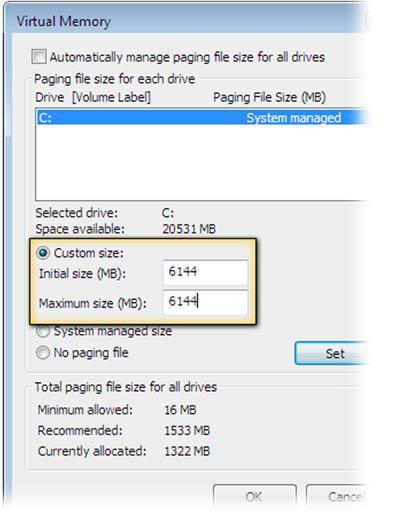HOW TO
Increase virtual memory beyond the recommended maximum
Summary
The instructions provided describe how to increase virtual memory beyond the recommended maximum. Increasing virtual memory beyond the recommended maximum enables users to export large map documents to PDFs that preserve all of the map elements.
What is virtual memory?
Virtual memory is simulated RAM. When all of the RAM in a machine being is used, the computer shifts data to an empty space on the hard drive. The computer swaps data to the hard disk and back to the RAM as needed. When virtual memory is increased, the empty space reserved for RAM overflow increases.
Having enough available space is absolutely necessary for virtual memory and RAM to function properly. Virtual memory performance can be improved automatically by freeing up resources in the registry.
Procedure
Warning: The instructions below include making changes to essential parts of your operating system. It is recommended that you backup your operating system and files, including the registry, before proceeding. Consult with a qualified computer systems professional, if necessary. Esri cannot guarantee results from incorrect modifications while following these instructions; therefore, use caution and proceed at your own risk.
The virtual memory is increased by accessing the system settings and then adjusting the virtual memory setting.
- Access the System Properties settings.
- Go to Start > Run.
- Type sysdm.cpl and click OK.
- In the System Properties dialog box, click the Advanced tab.
- Under Performance, click Settings.
- In the Performance Options dialog box, click the Advanced tab.
- Adjust the virtual memory setting.
Note: The Virtual memory section is at the bottom of the dialog box. The value following Total paging file size for all drives: is the size in MB of the system's virtual memory.
- In the Virtual memory section, click the Change button.
- In the 'Paging file size for selected drive' section, select the Custom size option.
- Set the Initial size (MB) and the Maximum size (MB).
Note: This defines the initial (base) size of disk space that Windows sets aside to be used solely for the purpose of virtual memory. The initial size can be matched to the maximum size, or both can be increased. Increasing the maximum size enables exporting large maps that would not normally export if the settings were at the recommended size.
Note: Microsoft recommends that virtual memory be set at no less than 1.5 times and no more than 3 times the amount of RAM on the computer. For power PC owners (most UE/UC users), there is likely at least 2 GB of RAM, so the virtual memory can be set up to 6,144 MB (6 GB).

- Click the Set button and click OK to close the dialog boxes.
If the virtual memory setting is too low and all virtual memory is in use, Windows may issue a warning.

Article ID: 000011346
- ArcMap
- ArcGIS Pro
Get help from ArcGIS experts
Start chatting now

